Some people who come to Vietnam marvel at the homes. They are unlike homes in any other part of the world. They are incredibly thin, sometimes only measuring a few meters wide, but seem to go back forever. These homes have multiple functions for virtually every aspect of Vietnamese life. Oftentimes, there is a business downstairs and maybe a kitchen in the far back. The lower floor amazingly converts into living quarters or maybe a massive communal area which could be used for dining, …for a meal hosting dozens of friends and family who stop by for a that special occasion. After the meal is finished, pull in the motorbikes and this area doubles as a garage and put out a few hammocks if any little brothers or little sisters need a place to crash for a few days or need to sleep off a little too much drinking from the night before.
How did this crazy utilitarian design come to be? It just seems too crazy for those of us who live in Western countries. I had to know why.
Lê era
In the 15th century Vietnam finally expelled yet another incursion by the Chinese following the Trần dynasty. After the Vietnamese were able to regain independence, they realized many of their cities were destroyed. This included the capital of Hà Nội. Emperor Lê Lợi built the citadel in Hà Nội. Mandarins (the administrator class) were required to live within the city limits and craftsmen gathered to meet the needs to this wealthy class.
Over time, craftsmen organized into guilds and started to group together. These trade guilds built their own self sufficient mini-villages within the city, each street specializing in their own manufactured product and even creating gates to the street, which would close when business was finished for the evening. This network of streets would be close to a place to unload raw materials brought in by various canals and rivers which brought raw materials into the city center to be distributed to their respective businesses.
In Hà Nội, as well as sections of other larger cities, this meant that each street would be named after a craft. Streets would have their craftsmen lining the streets, with adjoining streets containing the various raw materials one might need for their craft. If you wanted bamboo products, you would go to Hàng Tre (hàng being the word for merchandise, tre the word for bamboo), for sugar and sugar products you would go to Hàng Đường, …and so on. As an example (which may or may not be actual streets), Hàng Bánh (noodle street) might be located right next to Hàng Gạo (rice street) and various restaurants might be on yet another adjacent street.
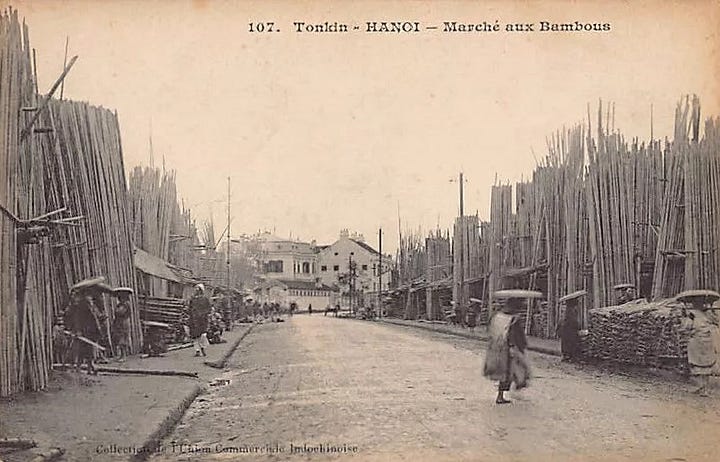
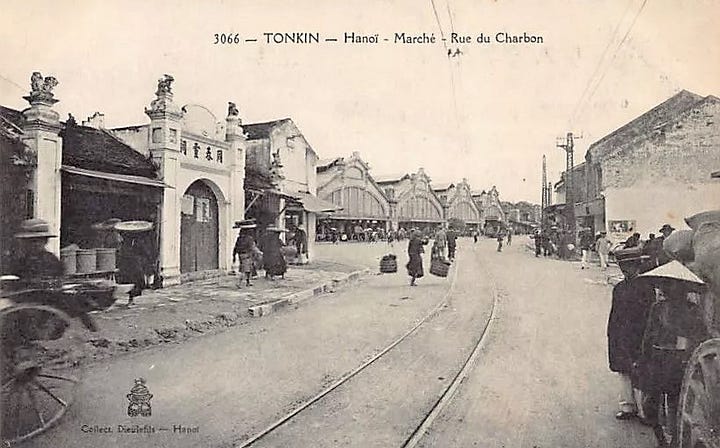
Land choice as well as the high quality building materials such as marble or ornate decorations would have been allotted to the high status Mandarin class. Building materials were still expensive at this time, as everything was handmade, so people made do with what was available.
The Mandarin class always had first choice of where to live. If you were the unfortunate merchant to be on a desirable piece of real estate, the Mandarin could kick you off your land any time they wished by issuing an eviction order. This unequal distribution in power would lead to growing civil unrest.
Many trade / shophouses were very basic, using the simple materials which could be harvested cheaply from the countryside. Mái nhà tranh (bundles of straw) are used in the north and lá dừa nước (water coconut fronds) are a type of ground palm grown in swampy areas of the Mekong where a large single branch grows upward to eight meters tall is used in the south. These are a couple examples of a couple available regional materials which would be used for building. I am sure this list is as long as a list of regions in the county. These simple materials were built in layers on a wooden framework of logs harvested from the local forests. The log framework would last several decades, but the exterior walls and roofs would need to have added or replaced layers applied every few years, with the exterior layer removed and another layer replacing the worn layer.
The black and white images below are typical of water palm building materials found in the south swampy areas, while the color photos are typical of what you might find with straw materials.



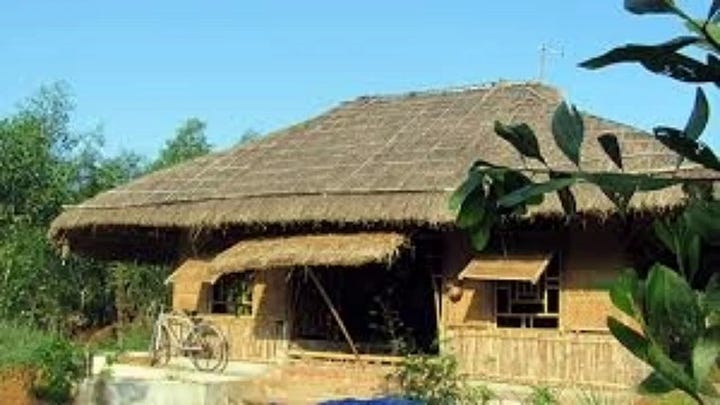
Nguyễn era
After the Tây Sơn wars, which followed years of wars between the Nguyễn and Trịnh lords, the Tây Sơn brothers overthrew the Nguyễn lords to install a new emperor and dynasty, the Nguyễn dynasty (haha, it is not at all confusing when everyone is named Nguyễn). The Chinese Qing Emperor sent troops to the Nguyễn lords, seeing an opportunity to influence Vietnam again, but these troops were quickly overrun and the three brothers named Nguyễn secured the country as well as taking most of the already subdued vassal state of Champa as well as the southern joint controlled Vietnamese / Siamese vassal state taken from the declining Khmer empire during the Nguyễn lords era. While the Nguyễn lords sought aid from the Chinese, the Tây Sơn faction sought aid from France, which eventually led to increased interest by France in the region.
Nguyễn Phúc Ánh, who himself was part of the Nguyễn lord lineage, united the land of the three Tây Sơn brothers named Nguyễn by taking control of all three factions and uniting them into one Empire. Nguyễn Phúc Ánh was renamed Emperor Gia Long (because I guess he got tired of everyone having the same name) and moved to Huế. I have trouble seeing how this war resulted in any meaningful changes to equality between the classes, but it did reshuffle the deck, allowing many of the peasants to advance with a redistribution of land.
Ironically enough, the Tây Sơn rebellion originated from previously Cham lands, so I guess the Cham somehow ironically got revenge for their subrogation over the previous few centuries prior, although the Tây Sơn brothers were not Cham.
Previously, southern lands of Champa and even parts of Khmer were under the influence of the Vietnamese with established Vietnamese settlements starting in the Lê dynasty, but never fully integrated. Tây Sơn leadership changed the mindset of Vietnamese, who used to only think of themselves as the northern people, but now, the Cham state as well as the former Khmer state were fully integrated into the Vietnamese state as symbolically represented by moving the Vietnamese capital to the central Vietnamese city of Huế, changing the borders of Vietnam into what we see today.
Hà Nội slipped into obscurity and the Mandarin court closed the city to foreigners. “…the court sought to institute a strict order of neo-Confucianism.” In the neo-Confucian order, traders and craftsmen were relegated to lower statues. In larger cities, this meant they could not build any building larger than two stories as well as limiting the width of the house and anything which may upstage a member of the Mandarin class. Everything was based upon social status, with even the amount of decoration or construction style dependent on social rank.
Since construction options were limited vertically, the city started expanding outward. Immigrants started to drain marshy areas and build homes and shop houses in sections of newly drained dry land. This created a shortage of land within the city center, which created a need for a new type of house, the tube house.
These houses would maintain the width and height requirements of the Mandarin code, but would allow the occupant to build as long as necessary to contain the working space needed by craftsmen as well as provide a living area for the extended family. Gradually, gardens in back of existing houses became sacrificed as more housing space was needed. Some houses would be only 2-4 meters wide, while extending back 20, 60 or even 100 meters (in some cases to the next block).
These tube houses served all functions of daily life, ie: the shop where family would manufacture products, the store where they would conduct business and the home where they would live. At this time, trades were a family business, so every family member, including the elder parents and young children would be involved. There may have been no school for junior except for the schooling provided by family members or other craftsmen in advancement of junior’s craft.
Here are some merchants selling their wares. There are grocers, people selling sugar and sugarcane juice, people making mats, lanterns, metal pots, …anything one might need in a growing city. In the countryside, there is no need to specialize because everyone does a little bit of everything. The move to an urban ecosystem created the need for specialization through competition and limited space, where every little craft would be delegated to a master of that craft. This ends up creating higher quality goods for lower prices.
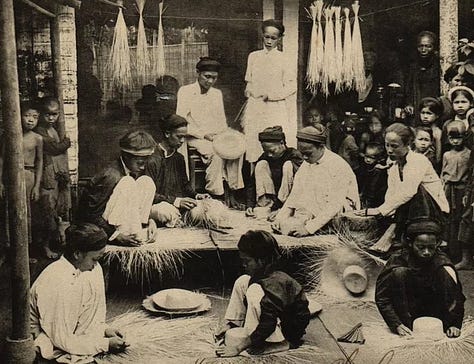
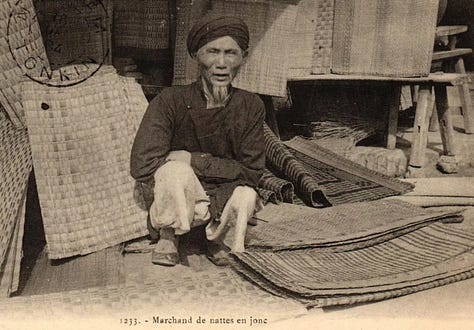
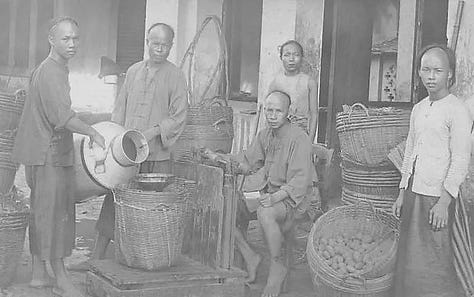
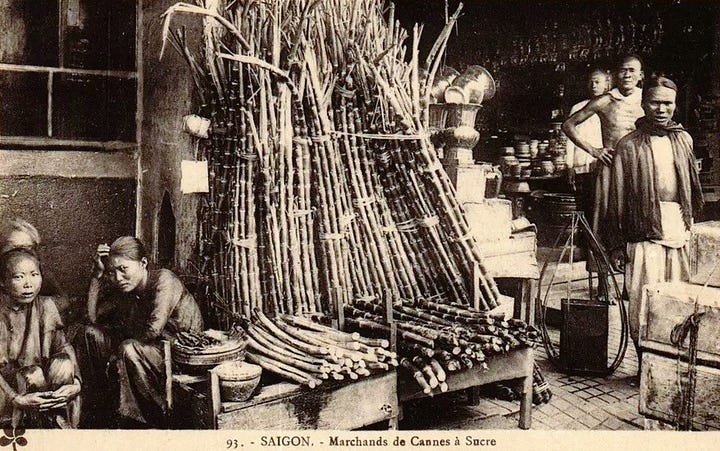
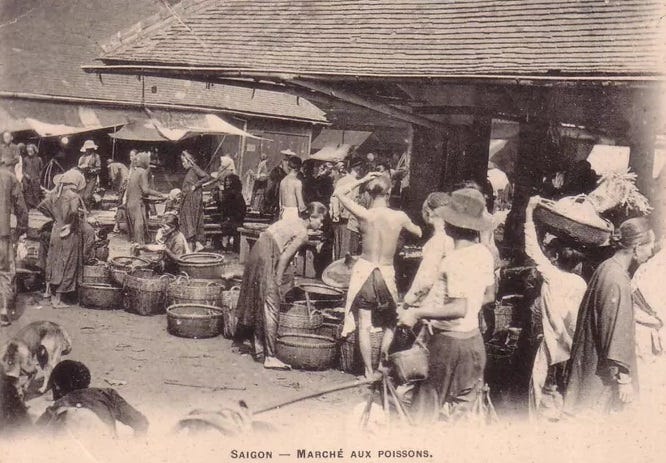
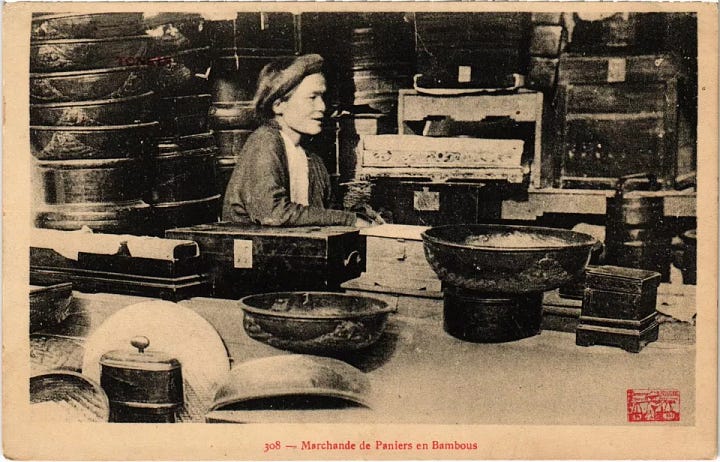
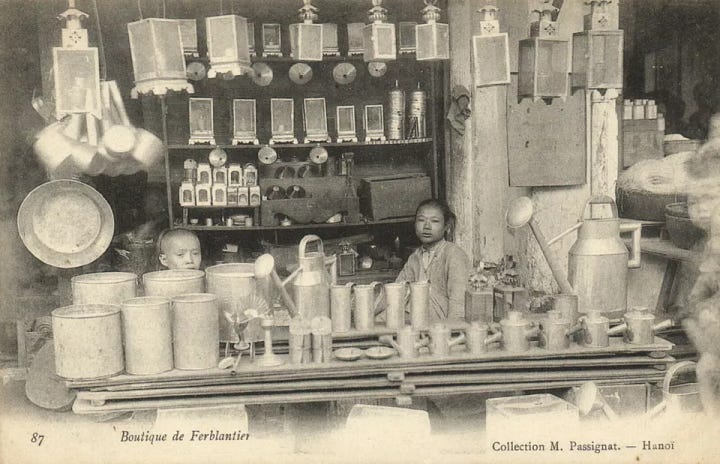
French Era
The introduction of the French changed everything. They had little respect for the Manchurian class. They left the royal family on their own to administer the governance of Vietnam, but when it came to actual policy, they were in charge.
In the case of Hanoi, this meant a relaxation of many of the Mandarin policies, including letting foreigners into the city, greater freedom in use of building materials and a better system of land ownership, which likely led to much more investment into people’s homes since they didn’t need to worry about eviction based on the whim of a Mandarin.
Building materials became more plentiful due to increased international trade and improved European manufacturing methods as well as improved building methods. Bricks and plaster replaced stone and ceramic tile replaced marble. No longer would an entire house need to be built out of stone and marble, when a thin facade mounted to a wall of concrete would do the job stretching the building materials available.
The first thing the French did in Hanoi was open up some new pieces of land for residential expansion. The French decided that Hanoi would become the capital of the state of Indochina, and they would need much more land to host the increased population of what would become the Paris of the far east.
The French opened up two new quarters, with a new French quarter and razed most of the citadel to add an additional quarter. The French initially tried to create French villas in Hanoi, but found the environment uncooperative, so many home builders took the Vietnamese concepts of high ceilings and good ventilation and applied it to French decor, with ornate facades and marble balconies one might find among the wealthy homes in Paris.
The French also didn’t see the point of having specialty streets all over the city to turn normal shopping into an all day series of errands. They created large markets in different parts of the cities for merchants to sell their wares. A product might be manufactured at home and shipped to the market to be sold by a family member or agent with a small booth in the market.
Central markets arose in cities around the country and introduced the rise of an increasingly wealthy merchant class. These markets are still popular today, still large functional markets distributing large quantities of goods to smaller markets around the country. Unfortunately, centralized markets did away with the old system of guild street markets, so guilds gradually became less important and street names merely became a novelty on a map. Craftsmen created less high quality products, hand crafted by a skilled artisan, shifting to mass produced products for local markets all over the country.
Many of the old French markets became specialty tourist markets, still thriving in the larger cities, selling little knick knacks tourists like to take home and pass out to their friends.
Here is a new French style market in Long My.
American Era
After the French, Vietnam basically splits into two countries with the U.S. controlling the southern government. Economically, this was a boom time for many southern cities. This period introduced a contemporary style to the Vietnamese home. Materials such as stainless steel, concrete and large tempered glass were used to give a simpler look to the building. Tinted tempered glass allowed large floor to ceiling windows to give more interior light. Balconies became a little smaller and began to house the exterior part of the air conditioning unit.
Colors of homes started to change as they drifted from the typically yellow and white encountered in colonial era homes, to add a much wider spectrum of exterior paints. Lighter colors such as tans, browns, grays or blues were introduced to add some individuality. Floor count started to rise as these small units were going up to four, five or even more stories.
Soviet Era
This era was a departure of the French and American eras, which could have been thought of as a facade of opulence. The Soviet era was a movement toward extreme simplicity. Buildings became squarer with little exterior decoration. The outward displays of wealth were discouraged. Building materials were replaced with cinder block and stainless steel. Balconies dropped their columns and became square, with maybe a stainless steel railing along the top. Exterior fencing became cast iron. In a word …. boring!
This isn’t only true of the housing, but the municipal buildings at the time. The party committee buildings, the bridges, even the Hồ Chí Minh mausoleum. All very sterile with the look of a Soviet block house. This isn’t just my opinion. Architects of the 1990’s were vocal of this sterility as they sought to bring back something a bit more “Vietnamese” in the Đổi Mới era, starting with the reforms of 1986. The new era would seek to join together all of the influences I have mentioned from the last 500 years of architectural history.
Modern Era
All around Vietnam, this new style started to become the Vietnamese style, with the long (tube) house, forced to narrow by the Mandarin class centuries earlier. The house now became the primary method of communicating wealth and power. The tube house changed construction materials into light colored brick, stone and concrete to give the appearance of a cleaner and brighter interior. The French style gave the Vietnamese look with ornate exterior with sometimes gold painted cast iron exterior gates, ornate marble (or faux marble) balconies and large solid wooden doors. This was all to give the feeling of opulent wealth, in an arms race with the neighbors to see who could win the gaudiest neighbor award.
Even if you are not in contention for this special award, you can see, from the villa above, elements within many Vietnamese houses: high ceilings, ornate balconies, ornate exterior fence, small interior courtyard, tall windows, etcetera.
Today we find elements of these influences in row after row of thin tube houses and extravagant villas all over the country. Some are utilitarian Soviet blockhouse types, some integrate the French style, still others bring in inspiration from other parts of the world. …But the basic style is still uniquely Vietnamese.
I really owe a lot of thanks for the information within James Edward Goodman’s book Uniquely Vietnamese. Much of the history of Vietnamese housing in this article comes from that book and I recommend giving it a read if you have access to it. There are sections of many different aspects of Vietnamese culture and it really opened my eyes to things I didn’t know that I didn’t know. I will probably write another half dozen posts based on some info I gleaned from that book.

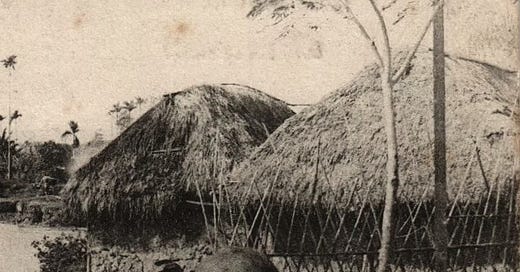

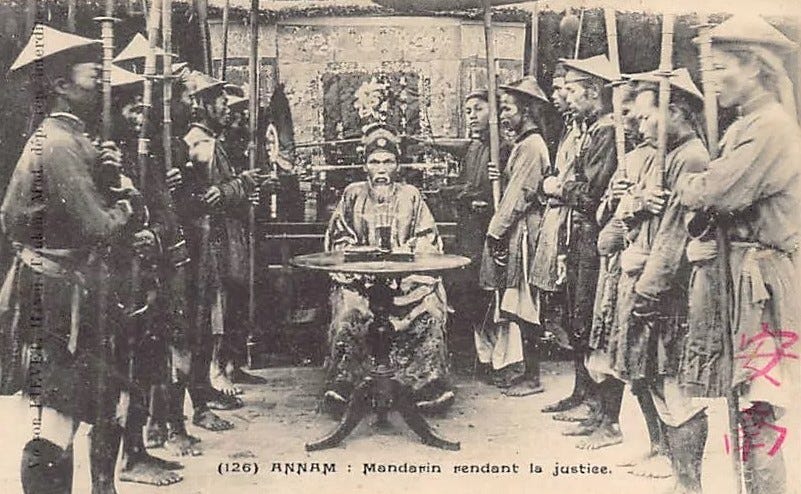


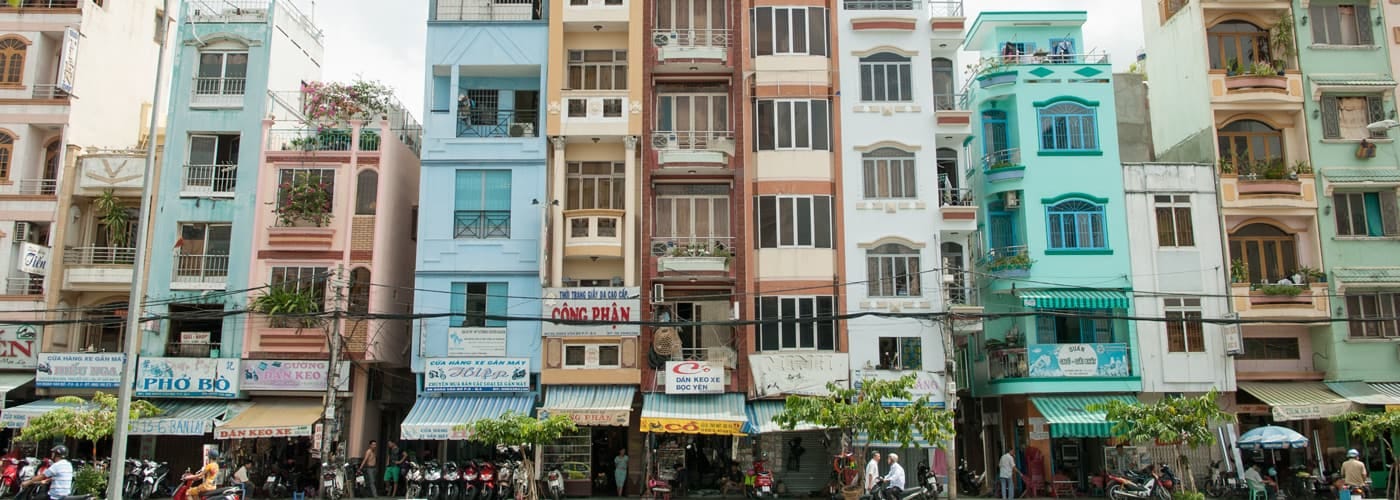
Reading about the tube houses, I remember when in Da’ nang we were taken to a “restaurant” which was through a sort of shop front, past the kitchen which was below the open living quarters, to outside on a jetty where we were served our meal. Included were prawns which needed to be shelled and when I asked where to put the shells, the answer was, off the pier, my husband was given a beer which they had put ice in which he quickly disposed of. I am taking about 27 years ago. Our daughter and her husband were there recently and it definitely has changed considerably.
Another interesting article.
"These trade guilds built their own self sufficient mini-villages within the city, each street specializing in their own manufactured product." I've often wondered why like businesses are clustered. Thank you for explaining this.